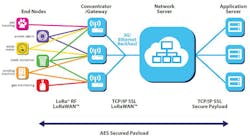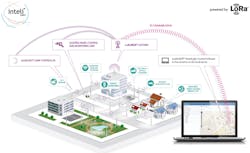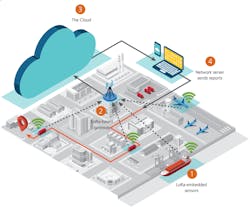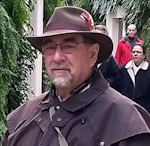LoRaWAN Brings the IoT Across Longer Distances (Part 2): Applications
This article is part of the TechXchange: Wireless IoT Technologies.
Members can download this article in PDF format.
What you’ll learn:
- How LoRaWAN's open, IP-based architecture encourages the development of low-cost solutions to directly interoperate with internet technologies, including many cloud services.
- How LoRaWAN can be used to provide a unified infrastructure for delivery of smart-building and smart-city services.
- How LoRaWAN's low-power, long-distance capabilities enable it to economically track freight containers and the trucks that haul them.
In Part 1 of this series, we looked at the demanding requirements placed on low-power wide-area networks (LPWANs) used to support Internet to Things (IoT) applications, and how LoRaWAN was architected specifically to meet them. The protocol's foundation is a sub-GHz spread-spectrum RF PHY that uses variable length chirp modulation to reliably communicate across exceptionally long distances using very low transmit power levels.1,2
Part 1 also introduced you to the "star" topology used by LoRaWAN networks and the basic encryption and verification features that support highly secure wireless data communications amongst three different classes of devices (Fig. 1).
In Part 2, we conclude with how these features can be used to implement a wide variety of applications in an equally diverse range of environments.
Open Standards, Open Specification, Open for Business
Choosing the best technology for a particular application involves a complex set of tradeoffs in terms of performance, power consumption, solution cost, and the environments it will be used in. Since these requirements vary so widely, the LoRaWAN specification is structured to provide and support openness that enables the most extended array of options.
LoRaWAN’s core technologies are based on the same open-standard protocols used for the internet itself, namely, TCP/IP. This means that LoRaWAN-based solutions can and do directly interoperate with internet technologies, including many cloud services, and they integrate easily with other communication technologies (e.g., satellite, cellular, Wi-Fi, and Bluetooth). Using open standards assures both vendors and users that there’s no vendor lock-in and their choices are future-proof.
Since the LoRaWAN protocol is based on open standards, it can take advantage of existing, proven protocols and designs, such as IP multicasting. Thus, deploying a LoRaWAN standard-based sensor and control network doesn’t require huge investments in either engineering design or infrastructure.
It’s often as simple as purchasing a base station, configuring a network and application server with a cloud service provider, and “joining” end-point sensor nodes to the network. For example, a complete private sensor network consisting of hundreds of sensors, three base stations, and cloud services can be purchased for under $1,000 and installed in a matter of hours.
Wireless LoRaWAN Applications
LoRa's low-cost and robust characteristics make it suitable for a wide range of applications in both the private and public sectors. Here’s a small sampling of the ways it’s being used today.
Smart Cities/Smart Infrastructure
Municipalities can use a single LoRaWAN network to create a unified infrastructure for multiple public services. By connecting city services such as lighting, parking, waste removal, and more, cities can optimize the use of utilities and personnel to save time and money.
For example, adding LoRa-based sensing and control to municipal streetlights enables lighting levels to be adjusted from low standby levels according to whether sensors detect vehicular or pedestrian traffic (Fig. 2). It also allows for traffic lights and other distributed assets to detect failures and request repairs.
Smart Buildings
It's easy to add intelligence to apartments, offices, and other large buildings by installing a central LoRaWAN control hub that communicates with smart thermostats, wireless sensors, lighting controllers, and other energy-aware devices using low-power LoRa Technology:
- The building’s LoRa-enabled smart thermostats can run pre-programmed energy-saving schedules that allow for an area to use less heating or cooling during times they aren’t expected to be occupied.
- The control hub also keeps a close eye on the cost of electricity as it varies throughout the day. It can schedule high-demand appliances, such as washers, dryers, dishwashers, and water heaters, to run during low-demand periods, when electricity pricing is low.
- The building’s controller hub also bridges between the building’s LoRa-based machine-to-machine wireless network and its Wi-Fi based wireless LAN. As a result, users can monitor and control the lighting, HVAC, and other functions using a personal computer, tablet, or smartphone app.
LoRa technology’s robust transmission characteristics let wireless sensors, controllers, and energy-aware devices located throughout the structure to reach through multiple walls, floors, and other structural elements that’s not possible with other wireless technologies. LoRa’s native IP capabilities make it easy for the smart building to access the IoT and connect to a cloud-based management application.
Fleet Telematics + Stolen Asset/Cargo Location
The infrastructure for a LoRa-based fleet and asset-tracking solution consists of one or more wireless gateways distributed across a campus, city, state, or other area of interest. The gateways can be deployed as a private network or added to an existing LPWAN infrastructure, such as those used by cellular carriers and cable operators.
A LoRa-enabled gateway can communicate with any asset equipped with a low-cost, low-power radio that supports the LoRaWAN protocol. When embedded within a sensor module, it can be used to detect unauthorized use and theft in trucks, construction equipment, or other motorized assets.
When used with freight containers, LoRaWAN can also support remote monitoring of conditions such as temperature, shock, vibration, or tampering. Furthermore, it’s possible to determine a LoRa-equipped asset’s location and direction of travel using radio triangulation (Fig. 4).
In this scenario, cargo containers, vehicles and other high-value assets are equipped with a smart, self-powered, sensor module that can detect unexpected door openings, shock, or other signs of tampering. The sensor module’s embedded LoRa transceiver communicates with LoRa gateways using the LoRaWAN protocol.
The LoRa transceiver periodically transmits its status information to all LoRa gateways within its range (typically 5 to 30 miles). The gateways forward the packets and a precise timestamp (based on time of arrival) to a network server in the cloud. The network server sends the timestamp information to a location solver that uses a process of triangulation to generate a location fix for the asset. If in motion, its speed and direction are also calculated.
A cloud-based application server checks the asset’s status data for signs of tampering and compares its location, speed, and direction against a database of authorized locations, routes, and schedules. The asset’s actual coordinates are compared against its expected location or route of travel and any significant deviations are immediately flagged for further analysis.
If the application server detects a potential problem, it can automatically send real-time alerts about tampering or unauthorized movements to security or law enforcement teams. These alerts include the asset’s present location and anticipated route of travel, thereby enabling its swift recovery.
Part 1 of this series looks at the technology behind LoRaWAN.
Read more articles in the TechXchange: Wireless IoT Technologies.
References
1. “LoRa and LoRaWAN: A Technical Overview,” Semtech, 2019.
2 - Umber Noreen, Ahc`ene Bounceur, Laurent Clavier “A Study of LoRa Low Power and Wide Area Network Technology,” ATSIP'2017.
3. “What Is LoRa?,” LoRa Alliance.
4. LoRaWAN Technical Specifications, LoRa Alliance.
Additional LoRa Alliance white papers on wireless security, LPWA technology, applications, and other topics can be found here.




